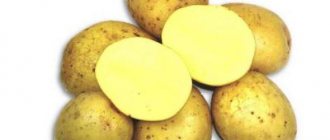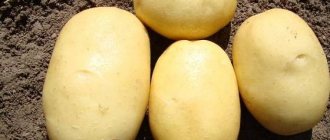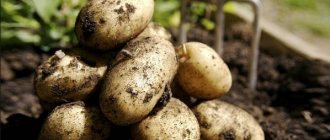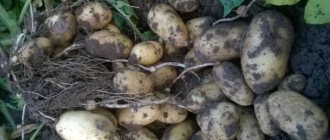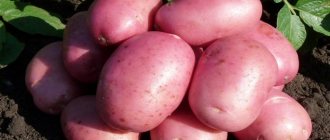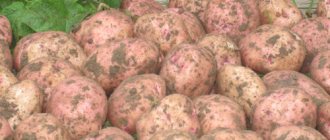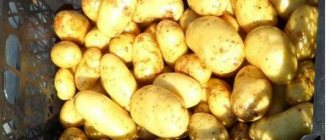Characteristics of potatoes in detail
Rocco is considered a mid-season varietal variety. Some consider it a late variety. Potatoes ripen 5 months after planting in the ground. Gardeners harvest up to 12 root crops from one bush. Rocco has excellent taste. It can be used for both boiling and frying. During heat treatment, the vegetable does not lose color - it remains creamy white.
The product is also resistant to diseases, including viral ones. Tolerates drought and is unpretentious in cultivation. The seedlings are taking root well. Potatoes keep well.
The weight of one potato reaches 125 g. The fruits themselves have a good taste and smell. The pulp is creamy white, the peel is pale pink, smooth, thin. Potato bushes reach a height of up to 50 cm. The stems grow vertically upward. The flowers are lilac with a burgundy tint. Sometimes potatoes of this variety do not bloom, but this does not stop the active growth of tubers.
The table shows detailed characteristics of Rocco potatoes:
| Variety name | Rocco |
| general characteristics | mid-season table variety (tubers are large, smooth, red) |
| Maturation period | 100-150 days |
| Weight of marketable tubers | 100-125 g |
| Number of tubers in a bush | 8-12 |
| Productivity | 350-400 c/ha |
| Keeping quality | 89% |
| Consumer qualities | excellent taste, color retention when cooked, used for chips and French fries |
| Starch content | 13-16% |
| Peel color | red |
| Flesh color | cream |
| Disease resistance | has strong immunity against many diseases |
| Preferred Growing Regions | any soil and climate |
The variety contains 13-16% starch, which is why French fries and crispy chips are made from it.
Potatoes Rocco: taste qualities
Breeders promise, with proper cultivation, a yield indicator of 13 - 26 tons per hectare of land. An average of 12 tubers grow in one nest, each weighing from 75-125 grams. Rocco potatoes have good taste characteristics, are intended for table use, are perfect for preparing any dishes, and do not fall apart or darken during heat treatment. The pulp is not watery, crumbly with pleasant external characteristics. The level of starch contained in potatoes is 13-14%. Rocco potatoes also have high potato keeping quality and marketability, amounting to 90% and 96%, respectively.
Rocco potatoes: photo of variety
Positive qualities and disadvantages of the variety
The variety has a numerous list of advantages and a minimal number of disadvantages.
| pros | Minuses |
| Average resistance to late blight of tubers and relatively average acclimatization in the northern regions. |
Description of culture
Rocco was bred by Dutch breeders and is popular all over the world. It is grown in Australia, the Netherlands, Spain, China, France and other foreign countries. In Russia, the variety began to be cultivated in 2002; its subspecies are common in Belarus, Moldova, Kazakhstan and Ukraine.
The fruits are also in demand among the population, as they are not susceptible to diseases - the pulp is clean, without eyes.
The Rocco potato variety is high-yielding; one bush produces 1.5 kilograms of vegetables, and producers harvest up to 600 centners of high-quality potatoes from one hectare of land in a good year. The fruits are of high quality - the amount of marketable vegetables from the plot is more than 95%.
This is a type of table purpose - used in restaurants to prepare French fries and other popular dishes. The variety is also widely used in home cooking - the fruits make delicious pancakes, dumplings, and purees. The taste of potatoes is sweetish.
It has a light pink skin. The pulp is creamy yellow, the fruit contains up to 16% starch. When cooked, the fruits do not change color.
Due to its high transportability and keeping quality, the variety is successfully exported. It is grown by large farms for sale and production of starch. Ordinary summer residents love the variety for its ease of care and high yields.
How to prepare the soil and tubers for planting?
Rocco potatoes are a variety that can adapt to any climatic conditions, which makes planting much easier. The soil for planting must be fertile.
To preserve their original shape and to prevent the tubers from becoming deformed, they must be planted in loose soil. In hard soil, potatoes may lose potential varietal properties, which will lead to crooked fruits.
Choose a flat and well-cleared place where snow and moisture from precipitation will not linger. Potatoes like moderate moisture. The site should be prepared in the fall:
- Under deep digging, add wood ash and humus. Be sure to add peat or any other material to structure the soil - it should be podzolic-turf, light loam or sandy loam.
- It is better to purchase seed material in specialized stores or leave your own. With proper storage of tubers, you will be able to get a good and rich harvest. For planting, use healthy potatoes that have not been subjected to mechanical damage.
- Before planting, treat root crops, preferably with copper sulfate, boric acid and potassium permanganate. Of the special preparations, the use of Epin is recommended.
Fight against possible diseases and pests
Rocco potatoes have high resistance to diseases and pests, but if the rules of cultivation and care are not followed, the root crop can become infected with late blight. Late blight is a dangerous fungal disease caused by the late blight fungus, which can lead to the death of potatoes. Often this disease occurs when the soil is waterlogged. When the first signs are detected, the plants should be treated with fungicides. As noted by gardeners, the Colorado potato is not a fan of this variety, but in any case, preventive measures should not be neglected. It is always better to prevent diseases and pest attacks by treating the seed material with specialized preparations before planting than to fight diseases and pests - which does not always end well.
Planting stages
Planting dates are selected based on the weather conditions of the region. In the central and southern regions, the second half of March or the beginning of April is considered the ideal time. With the northern regions, everything is a little more complicated, since you need to catch the moment - it may be early to plant potatoes in March, but if you are late by at least a few weeks, this can affect the yield reduction.
They dig holes into which they place a handful of ash - it helps enrich the root crop with starch or potassium. In order for Rocco to show all his best qualities, they follow the rules of crop rotation or plant green manure (lupine, clover, mustard) immediately after harvesting, but do not leave it for the winter, because dried grass will interfere with the normal melting of snow.
The planting depth should be up to 15 cm, the distance between the holes should be about 30 cm. If the potatoes are medium in size, place 1 potato in one hole, add several small ones. 500 ml of water is poured into the hole with the tuber and sprinkled with earth. The distance between rows is about 70 cm.
Potato feeding
Basic fertilizers are usually applied either in the fall, or when preparing the site for planting a given vegetable crop, as well as directly during planting potato seeds in the ground.
How to Grow a Rich Potato Harvest
During the period of potato growth, applying fertilizers under the bushes is quite problematic, because as a result of hilling, a fairly high mound grows around the tops (up to 20-25 cm in height). Therefore, fertilizing is usually not carried out during the season. But if desired, you can add a layer of organic mulch (humus or compost) immediately before flowering begins.
Care
Rocco potatoes are a moisture-loving variety, so an important process is to ensure regular and abundant watering, at least 3-4 times a week. The best way to retain the necessary moisture is to use products intended for the mulch layer.
It is important to carefully care for the soil, weed the beds, removing weeds, and regularly loosen the soil, which will ensure excellent air exchange. Be sure to fertilize the soil and feed the plant itself. In this case, it is recommended to use traditional methods - specially developed drugs. Traditionally, plants are fed with organic and mineral fertilizers. Tubers will be more resistant to external factors if there is a sufficient amount of phosphorus, nitrogen and potassium in the soil.
How to preserve the harvest without loss
Rocco potatoes, judging by the descriptions of the variety and reviews of potato growers, are an unpretentious plant that adapts well to any conditions of the surrounding world.
And what about the safety of grown root crops?
- If appropriate temperature conditions are created in the storage and a certain air humidity is maintained, then the preservation of potatoes approaches 100%.
- For storage, you can use wooden boxes with slots or nylon nets.
- Tubers are practically not damaged even when transported over long distances.
Potato diseases and pests
Rocco potatoes have weak immunity to the fungal disease late blight. The disease spreads in the second half of summer, which is why mid-season and late-ripening potato varieties are most susceptible to infection. Potatoes are also attacked by the Colorado potato beetle.
| Disease/pest | Development of the disease | Prevention and control methods |
| Late blight | Late blight manifests itself as dark spots on the leaves, after which they begin to rot, and the infection gradually spreads to the stem and tubers. If no measures are taken, the crop will be completely destroyed. |
When plantings become thicker, moisture stagnates, causing the plants to be poorly ventilated, thereby creating favorable conditions for late blight. This should be avoided. |
| Curling leaves | The variety has average susceptibility to a viral disease, in which the lower leaves curl and become stiff. This leads to slower plant growth, weakening and paleness. | Preventive measures include the following:
|
| Colorado beetle | A common pest that can seriously damage crops. Eats young potato leaves, leaving bare stems. This disrupts the supply of nutrients to the roots, which stops the development of tubers. | To combat the parasite, beetles are collected by hand, checking the lower part of the leaves for the presence of eggs of the pest - they are orange-yellow in color. Leaves with eggs are torn off, placed in a separate container, and then burned. They also set up traps for beetles in the spring: they dig holes and put chopped potatoes there. The beetle will awaken after winter and crawl out to the bait. Spray with special chemicals strictly 1 month in advance. before harvest. |
Immunity
This is not the strongest variety in terms of the immune system. But most of all, Rocco potatoes are susceptible to late blight, since they are not early varieties.
We recommend reading: “Description of the Labadia potato variety”
As you know, this fungus can easily destroy up to 30-50% of the crop in a short period of time. To prevent this from happening, it is necessary to take a number of preventive measures:
- Select only healthy tubers for planting material.
- Do not store infected root vegetables next to healthy ones. Sick tubers must be disposed of immediately.
- Treat seedlings with special fungicides such as Ridomil Gold, etc.
If signs of late blight infection appear on the leaves (the leaves darken and rot), then the infested areas must be immediately removed and the remainder of the crop treated with special pesticides. After 2 weeks, re-treatment is carried out.
How to properly assemble and store Rocco?
In the fall it's time to start harvesting. It must be carried out in a timely manner so that the fruits do not begin to deteriorate and rot. The ripeness of potatoes is determined by monitoring the condition of the tops. When it starts to dry out, the tubers are actively growing and it’s time to harvest
The harvest is dug up at the end of August and until the second half of September. Before harvesting, dry tops are mowed and removed to avoid possible infection of the tubers.
After the potatoes are dug up, they are laid out on the site in one layer to dry. Then they are laid out in wooden boxes or special nets. Leave some potatoes as seed for next year.
Harvest and storage
A good crop shelf life is ensured by compliance with the rules of collection and storage.
How and when to collect
The harvest is collected in a timely manner. Otherwise, there is a risk that the tubers will begin to deteriorate and rot. The timing of digging up potatoes is determined by the condition of the tops. It should turn yellow and dry out. A test dig is recommended to determine the degree of maturity of the potatoes.
Reference . After the tops die, the potatoes must be dug up before the rains. The optimal time for harvesting is from late August to mid-September.
On the eve of digging up the tubers, the tops are mowed and removed. This will prevent them from becoming infected. Potatoes removed from the ground are dried before being placed in storage boxes.
Storage features and keeping quality of the variety
Potatoes of the Roko variety are distinguished by a high percentage of keeping quality, which is 88-89%. It tolerates long-term transportation well. Tubers are stored in wooden containers or nylon nets in the cellar. Slots are pre-made in the boxes. Favorable conditions must be created in the room - darkness, lack of moisture and not too low a temperature.
Reviews from farmers and gardeners
Today there are many reviews about Rocco's potatoes on the Internet - most of them are positive. Some farmers note the variety’s unpretentiousness in care, while other gardeners grow it due to its high yield.
★★★★★
Innocent, 54 years old, Kostroma, farmer. Not long ago I asked my neighbor for potatoes of this variety to try how they would manifest themselves in development and what kind of harvest they could get.
At first there were only five bushes in my garden, but today their number has increased several dozen times. I liked the unusual taste, its high yield and ease of care. Sometimes I forgot about watering the plants, and this did not affect the appearance of the tubers. ★★★★★
Angelina, 35 years old, Samara, owner of a large vegetable garden. I have yet to plant Rocco myself.
One day my friend treated me to mashed potatoes. I was surprised at how tender and pleasant it tasted. Did you clarify what type of potato it is? She answered and in addition gave tubers for planting. I am sure that I will not regret my idea, because the garden cannot stand empty. ★★★★★
Dmitry, 65 years old, Novosibirsk, gardener. Rocco caught my eye when neighbors in the country planted him.
The bushes are erect, the leaves are dark green, wavy, the branches are spreading. A neighbor said that every year she collects 10 large potatoes from one bush. I decided to try planting some seed tubers in the spring. My wife approves of my decision, because she herself has heard more than once from colleagues about Rocco’s taste and attractive appearance. Hide
Add your review
If you take the cultivation of Rocco potatoes seriously, you will be pleased with a stable harvest in large quantities every year. This variety has gained popularity in many countries of the world, and this is confirmed by high yields, good presentation, the ability to sell the vegetable and make a good profit.
0
0
Copy link
Botanical properties
When choosing a variety, gardeners take into account the characteristics of the vegetable, preferably potatoes:
- matured quickly;
- wasn't sick;
- gave a good harvest;
- stored with minimal waste.
Rocco potatoes, according to the variety description, photos of finished products and reviews from vegetable growers, fully meet the requirements:
- The tubers are pinkish-red, oval, smooth (as in the photo below), the flesh is soft cream. The color does not change after cooking.
- Potatoes weighing up to 125 grams, more than 10 in a bush. The total weight of one bush is about 1 kg 500 g. If you look at it on a large scale, you can get up to 400 centners per hectare.
- Plants can be distinguished from other varieties by their upright bushes, large juicy green leaves and red or purple inflorescences.
Attention! Sometimes inflorescences do not form at all, but the yield of Rocco potatoes does not suffer from this.
Advantages
Breeders have worked on the vegetable for many years, achieving unique properties. The result was potatoes of the Rocco variety, which are not afraid of many of the diseases of its relatives. The vegetable does not get sick:
- potato cancer;
- golden potato nematode;
- wrinkled and striped mosaic;
- striped mosaic;
- virus Y;
- The leaves practically do not curl.
Scientists managed to reduce tuber late blight, but leaf blight could not be completely eliminated.
Photos describing the variety are increasingly appearing not only on websites, but also in user correspondence and in their reviews of Rocco potatoes. There is nothing surprising here, because this vegetable has many other advantages:
- Mid-season potatoes ripen 3 months after germination.
- Plantings provide plot owners with a rich harvest.
- High starch level: 15-30%.
- Excellent taste, judging by reviews from vegetable growers.
- Able to withstand fluctuations in temperature and soil moisture. Therefore, potatoes of this variety can be grown in any climatic regions of Russia and Europe.
The best potato varieties - choose early-ripening root crops
To date, more than 450 varieties have been registered in the Russian Federation, which are recommended for cultivation and are of industrial importance with a ripening period of only 50-60 days. Their yield ranges from 200 c/ha to 800 or more. Let’s take a closer look at the main “hits” that are currently grown in the Russian Federation.
Variety Scarlett. In 55-60 days it reaches the stage of technical ripeness, has very good taste, boils quickly and is used to prepare many dishes. A special feature is its frost resistance and resistance to late blight, cancer and nematodes. Even without special treatment, the Red Scarlett potato variety is not affected by these diseases; the bush grows to 45-50 centimeters in height, after which it begins to bend towards the ground - the first sign of the technical ripeness of the tubers. Scarlett potatoes yield up to 950 kg/acre. To do this, it is necessary to provide the best conditions for growth - watering and enough sunlight. The average size of one root crop is 140-160 grams, but if there are few of them under one bush, they can reach 250-400 g. Red Scarlett potatoes do not tolerate drought well, so it is necessary to monitor the condition of the top layer of soil and not overdry it.
Variety Hack. It is the result of developments by Dutch breeders, bred in 1995, but is still particularly popular with farmers who can provide the plant with good watering and high-quality treatment against pests. It is very sensitive to heat and moisture, and is highly susceptible to attacks by the Colorado potato beetle and nematode. Despite their high susceptibility to pests and diseases, these earthen apples are capable of producing a harvest of up to 1000 kg/acre, which is why they are liked by many summer residents. The tubers are very large (up to 250 grams each), have a regular oval shape, and are yellowish (an advantage for those who need a good presentation of the product). The bush grows up to 70 centimeters in height, the stems fall only after the apples reach technical ripeness. The ripening period is 56-63 days from the moment it hits the ground and provided that the planting material is abundantly watered.
Variety Elizabeth. The result of the work of the Volga selection site is perfectly acclimatized for temperate latitudes. It has a yield of up to 45-50 tons per hectare, does not require abundant watering and can withstand drought well. Tubers weighing 150-200 grams can be obtained even without watering. Nematodes and powdery mildew do not damage the plant. With proper and timely treatment for the Colorado potato beetle, the stems remain untouched by other pests and are rarely attacked by them. Keeping quality – 96% with marketability of 87%. Elizabeth potatoes are one of the best export options, as they are easily transported and can sit for a long time without rotting.
Variety Karatop. Despite the yield of only 35-40 tons per hectare, Karatop potatoes are one of the best in the Russian Federation. Such popularity of the vegetable largely depends on its taste. The tubers boil very quickly and easily, have excellent taste and can be used for preparing first and second courses. The plant has very great vitality and starts quickly in the first weeks of its development, due to which it is ahead of the weeds and the row spacing has to be cultivated 1-2 times less than when growing ordinary potatoes. Karatope is recommended for cultivation in the southern regions, as it needs the sun for proper photosynthesis. It is not picky about moisture, but it needs to be watered at least 2 times a month in the absence of precipitation.
How to care for seedlings
The Rocco potato variety is absolutely unpretentious in care, which is often very captivating for gardeners. You will need to perform the simplest manipulations to care for potatoes:
- this variety, as mentioned earlier, is not afraid of either drought or rain. But if the summer turns out to be dry, ensure regular watering of the potatoes, especially during the flowering period, avoiding the soil from drying out, this will certainly affect the harvest. But also avoid overwatering, as this can lead to the development of diseases;
- Don’t forget about fertilizing, potatoes react very favorably to it. It is recommended to water with a solution of mullein with chicken droppings, or use saltpeter;
- One of the most important activities for caring for potatoes is hilling. It must be carried out a couple of times a season; this is done in order to protect the seedlings from temperature changes, as well as to ensure that air, nutrients and moisture reach the root system, as well as to maintain the tops and to control weeds.
Reviews about the variety
Gardeners note the excellent taste and high yield of the variety.
On fertilized soil, the tops grow tall and spreading, and the potatoes are large in size. Harvesting Rocco is quite convenient due to the compact arrangement of root crops.
We invite you to familiarize yourself with potato varieties that have different ripening periods:
| Late ripening | Early ripening | Very early | Mid-late | Mid-early |
| Nikulinsky | Borovichok | Forty days | Crane | Yanka |
| Cardinal | Elmundo | Karatop | Sorcerer | Giant |
| Rocco | Felox | Riviera | Mozart | Tuscany |
| Kiwi | Bellarosa | Zhukovsky early | Grenada | Purple Haze |
| Ivan da Marya | Natasha | Farmer | Melody | Openwork |
| Picasso | Ariel | Minerva | Margarita | Santana |
| Asterix | Queen Anne | Veneta | Ramona | Desiree |
| Slav | Arosa | Kiranda | Dolphin | Lady Claire |
